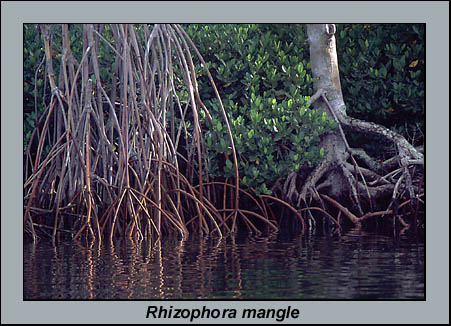Red Mangrove
Rhizophora mangle
Family: Rhizophoraceae
Natural History

The red mangrove is one of the four mangrove species found in the mangrove ecological community. The other species within this community are the white mangrove (Laguncularia racemosa), black mangrove (Avicennia germinans), and buttonwood (Conocarpus erectus). Scientifically, they are distantly related and are only grouped based on ecological function within the community.
The mangrove community plays an important role in tropical and subtropical regions of the world. Different mangrove species protect and stabilize low lying coastal lands and provide protection and food sources for estuarine and coastal fishery food chains. Mangroves serve as feeding, breeding, and nursery grounds for a variety of fish, shellfish, birds, and other wildlife. Mangroves also produce 3.6 tons per acre of leaf litter per year which benefit estuarine food chains. An estimated 75% of the game fish and 90% of the commercial species in south Florida depend on the mangrove system.
Their tall arching roots called prop roots easily identify the red mangroves. Prop roots supply air to the underlying roots and provide support and stability to the red mangrove. They also trap mud and silt that flows with the tide, thus gradually increasing the soil around them. They are found closer to the water than the other mangroves in the community due to their high salt tolerance. The wood is used for fuel, piling, crossties, and charcoal. The red mangrove is also known for its large quantity of tannins found in the bark. Red mangroves range from Daytona Beach and Cedar Key southward.
Waterfront development has strongly affected the habitat of mangrove communities. Removal of these trees and the destruction of mangrove wetland habitats endanger the natural systems of Florida's coastal zone. The result of removal or damage to the mangrove communities has affected Florida's coastal land by causing erosion and a decrease in food at the base of the food chain supporting commercial fisheries.
